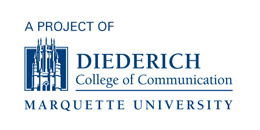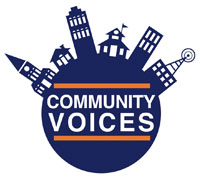
Photo: Courtesy of Take Root Milwaukee
Bethany Sanchez, director of the Fair Lending Program at the nonprofit Metropolitan Milwaukee Fair Housing Council, urges Milwaukee residents and organizations to take action to oppose changes that would weaken the Community Reinvestment Act. The CRA has resulted in billions of dollars of loans and investments in low- and moderate-income communities.
It seems like every day, we learn about attacks on our civil rights and on regulations that protect people and our planet. It can be hard to know how we can effectively push back on bad proposals. Here is a situation in which federal agencies are asking for our input. Let’s give it to them!
At first, this suggestion might sound dull or unimportant, but stick with me. You can let federal bank regulators know how you feel about a proposal by the head of the Office of the Comptroller of the Currency (OCC). The OCC is the regulator that oversees nationally chartered banks, including Wells Fargo, US Bank, Chase, BMO Harris, PNC, Associated and Pyramax.
The OCC is floating a proposal that would threaten Milwaukee, and the entire country. The proposal would change the requirements of the Community Reinvestment Act (CRA) to, among other things:
- Reduce current penalties for lending discrimination
- Change the current focus on low- and moderate-income communities, so that CRA will also include investment in higher-income communities, and
- Water down regulations that require banks to solicit community input on lending and other financial service needs, and that require the bank regulators to consider the community’s input on banks’ CRA performance regarding meeting those needs.
Here’s some background. As a response to banks’ illegal, discriminatory redlining, in 1977 a federal law called the Community Reinvestment Act (CRA) was passed. CRA requires banks to offer their services and loan products to all people within the communities where they do business, including low- and moderate-income people and communities. They must provide home and small business loans to credit-worthy borrowers, investments in community developments that serve low- and moderate-income people, and services including bank branches in low- or moderate-income census tracts, and low-cost checking and saving accounts.
The requirements of CRA have resulted in billions of dollars of loans and investments in communities that had previously been either ignored, or actively redlined by banks. Below are some examples of ways that CRA has benefitted Milwaukee:
- New mortgage loan programs and downpayment assistance for credit-worthy first-time homebuyers
- Home repair loans for homeowners
- Loans or investments in affordable housing or mixed-use developments, like the Villard Library and the Mitchell Street Library — both house a public library on the first floor and housing above; the Griot Apartments, mixed-income housing located above the new home for America’s Black Holocaust Museum and the Welford Sanders Lofts
- Investments in community facilities located in low- and moderate-income neighborhoods, like Walnut Way’s Innovations and Wellness Commons
- Financial assistance for nonprofit organizations that provide free or low-cost home repairs for extremely low-income, elderly or disabled homeowners
- Financial support for nonprofit homebuyer counseling agencies that have helped thousands of people to access the American Dream
- Bank staff who volunteer with organizations that provide financial counseling, homebuyer counseling, affordable housing development or small business development,
- Financial support and technical assistance to minority business development organizations, workforce development programs and nonprofit organizations that help with employment readiness
- Participation in Take Root Milwaukee, a partnership among nonprofit community groups, banks, government, Realtors, and philanthropic foundations, all working to help move residents from renting to successful, sustainable homeownership.
Before CRA was established, very few banks did these things. Indeed, they openly discriminated against people of color and redlined low income neighborhoods.
While progress has been made, efforts to combat lending discrimination must be increased, not weakened. In 2017, in the City of Milwaukee, 37.0% of the population was non-Hispanic white, but whites received 57.7% of the home loans, 40% was black or African American, but black borrowers received only 13.7% of home loans, and 17.3% were of Hispanic or Latino origin (of any race), but received 11.4% of home loans.
Even among people with modest incomes and impaired credit, if banks continue to work with us to address these lending disparities, together we can help borrowers become successful homeowners and create strong neighborhoods. Housing counseling, downpayment assistance, credit counseling, niche marketing, and loan officers who reflect the communities they serve have been proven to be effective.
Unless banks know that there would be penalties for discrimination against people of color, women, people with disabilities and other protected classes, illegal discrimination will increase!
The OCC has officially asked for community input on these, and other changes to the Community Reinvestment Act. Join the national effort by advocates for fair housing, fair lending and economic justice, to encourage as many individuals and organizations as possible to provide their comments on the OCC’s proposal.
To help you understand more of what we could lose if CRA were to be weakened, check out the comprehensive set of resources at www.ncrc.org/treasureCRA. Based on a report from the Philadelphia Federal Reserve Bank, the National Community Reinvestment Coalition (NCRC) estimates that nationally, low- and moderate-income neighborhoods could lose up to $105 billion in home and small business lending nationally over a five-year time period. This represents a 10 to 20% loss. In Wisconsin, that loss would be between $703.4 million and $1.4 billion, and in Wisconsin’s 4thCongressional district, which includes the City of Milwaukee, the loss would be between $141 million and $282 million.
I urge you to submit a short comment to the OCC, describing concerns that you learn about at www.ncrc.org/treasureCRA. On that website, as you scroll down the page, you can find sample comments that can be modified to be submitted by your church or community organization. To the right of that, are instructions for how to submit your comments online. Continuing to scroll down the page, you will see “PRINCIPLES FOR A MODERN CRA” and a toolkit including sample links, hashtags, key messages, graphics and more.
Join Sen. Tammy Baldwin, Community First, Plymouth Church, the Fair Housing Council and dozens of others: submit your comment. Let’s let the OCC know that they need to keep the “community” in the Community Reinvestment Act!








Thanks for this article Bethany.
This is a very complex topic and I’m trying to wrap my brain around it. Regarding the threats you enumerated above:
–Reduce current penalties for lending discrimination
–Change the current focus on low- and moderate-income communities, so that CRA will also include investment in higher-income communities, and
–Water down regulations that require banks to solicit community input on lending and other financial service needs, and that require the bank regulators to consider the community’s input on banks’ CRA performance regarding meeting those needs.
Can you be more specific and point to the documentation?
I am looking at the ANPR at https://www.occ.gov/news-issuances/news-releases/2018/nr-occ-2018-87a.pdf and at the “Community Reinvestment Act – Findings and Recommendations” published by the Dept. of Treasury on April 3, 2018
https://home.treasury.gov/sites/default/files/2018-04/4-3-18%20CRA%20memo.pdf
Also, can you provide the source for: “Based on a report from the Philadelphia Federal Reserve Bank, the National Community Reinvestment Coalition (NCRC) estimates that nationally, low- and moderate-income neighborhoods could lose up to $105 billion in home and small business lending nationally over a five-year time period. “?
Thank you!
Great article, Bethany!
As a “Big Sister” for a 19-year-old who has lived in poverty her entire childhood, I am trying to find her a stable housing environment. She has job opportunities in Milwaukee but nowhere to call home. It would be great for Milwaukee to have a lending “safety net” for young adults facing similar circumstances. Unlike children who continue to live with their parents until they complete their education, this is impossible for her. She and many others deserve a boost from our community, an upstart that she can be responsible to. If Milwaukee has enough resources to put in a multi-million dollar trolley system that serves a few, we should be able to build a lending system that would transport those living in multi-generational poverty to a more secure future.